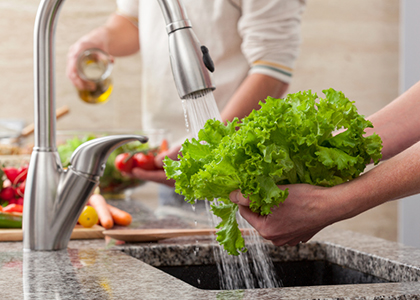
How to Properly Wash Your Produce
By Team Reboot
Have you ever popped a blueberry in your mouth before washing it and wondered, “Is it really clean?” Many people only wash their produce if it’s visibly dirty, or only if they remember, or maybe only if it’s conventional produce. Did you know that on average, just from the grocery store alone, up to 20 people may have handled your tomato before you pick it up?
Foodborne illnesses have become a serious issue. Just this past year we saw outbreaks with salmonella linked to cucumbers, a parasite outbreak linked to cilantro, and currently there is an ongoing investigation of alfalfa sprouts. It’s important that we know what to do to protect ourselves and it starts with nothing simpler than cold running water.
What’s the Best Way to Wash?
The following steps will help to limit the amount of residue and harmful bacteria on your produce:
- Thoroughly wash fruits and veggies under cold running water just before eating, cutting, or cooking (even if the rind or skin isn’t going to be eaten). Don’t fill your sink and let produce soak unless it’s produce with lots of nooks and crannies like broccoli or lettuce. For these items, soak in clean, cold water for 1-2 minutes in a clean bowl (not your sink), followed by rinsing and draining.
- For hard produce like melons, cucumbers, citrus fruits and potatoes, these should be scrubbed with a scrub brush under cold running water.
- For leafy greens, lettuce, and cabbage, first remove and discard the outer layers. Wash individual leaves under cold running water and shake to drain. Use a salad spinner or pat leaves dry with a clean paper towel.
- For bunched produce like grapes, or radishes, rinse in a colander.
- For apples and fruits with a stemmed tip, after rinsing, slice off the stemmed ends to remove any trapped bacteria in their crevices.
- Use your produce immediately after washing, rather than washing and storing in the fridge, which can lead to bacteria growth.
- Wash your hands, utensils and cutting board with hot soapy water before and after preparing food. Use separate cutting boards to avoid cross-contamination.
- Do not wash produce with soaps, detergents, commercial chemicals or detergents.
How to Use A Scrub Brush
A scrub brush has been shown to remove slightly more bacteria than just water alone. Use your brush on thick-skinned produce like melons, carrots and potatoes while washing under cold running water. The firm, nylon bristles in the brushes are perfect for scrubbing away microbes and are generally dishwasher safe and easy to handle.
What If It’s Organic?
Do I really need to wash my innocent looking organic blueberries? Yes! Even if it’s organic, there is a risk of microbes and harmful germs residing in the crevices, skins, and leaves of your produce. A 2006 study looking at farms in Minnesota and Wisconsin, found E.coli contamination similar in both organic and conventional produce. Researchers found E.coli’s presence was more dependent on the type of produce rather than whether it was organic or conventional (leafy greens being more likely to contain these microbes despite having been grown pesticide-free).
The bottom line: Both organic and conventional produce need to be thoroughly washed under cold running water.
Is Water Enough?
While commercial washes are highly advertised, research has shown there isn’t a whole lot of benefit over just using plain water. A study at University of Maine, found that water was the same, if not slightly better, at removing microbes. Another study at University of Tennessee, found no significant difference between the veggies washes and plain water.
The bottom line: Stick to cold running water and do a thorough wash, especially for fruits and veggies with tiny crevices like tomatoes and apples.
A Homemade Rinse
While the research shows it’s not really necessary, if you want to use a homemade rinse, it won’t hurt. Use a spray bottle with 3 cups water and 1 cup white vinegar. Spray your produce just enough to coat the surface, and then rinse it under tap water before consuming. Use your homemade spray for smooth skinned fruits and veggies like apples, pears, and cucumbers.
What You Don’t Need to Wash.
Pre-washed bagged lettuce is generally very safe and you don’t need to re-wash it again. If you still prefer to re-wash packaged greens, just be careful to avoid cross-contamination.
Items to Have in Your Kitchen
- Clean cutting board or surface to work on
- Scrub Brush
- Salad Spinner
- Paper Towels
- *Vinegar & spray bottle (optional to make homemade wash)